Field Measurements : Echo Return Loss & Loop Delay
Overview
The Measure Loop Delay/ERL application provides the capability to measure and display loop delay and echo return loss (ERL) on one or more timeslots. Multiple instances of this application may be opened simultaneously, allowing measurements to be taken on multiple timeslot ranges and measurement strategies.
Modes of operation. This application provides two basic modes of operation:
- Non-Intrusive: Two GL boards are used, one of which monitors the original signal while the other monitors the returned or looped-back signal. The board monitoring the original signal operates in outward loopback mode, so that the signal is forwarded by the board hardware while being monitored by this application.
- Intrusive: One or two GL boards are used. A signal is injected into one or more timeslots and the returned signal is monitored. The injected signal may be sourced either from a file containing A-Law or µ-Law encoded signal values, or may be a white noise (Gaussian) signal generated internally from within the application. The drop/insert feature of the GL boards may be used to pass through the traffic in channels not being tested by the application.
Theory of Operation
The application computes the delay by taking snapshots of the data stream on the receive and send paths. Snapshots are taken at approximately 2-second intervals, or as soon thereafter as permitted by the speed of the host machine. The send path snapshot is larger than the receive path snapshot by an amount corresponding to the maximum delay. It then computes the statistical correlation between the receive path and send path data streams at each successive point in the send path stream. The offset giving the highest correlation is taken as the delay in the returned signal. The return loss (ERL) is then calculated as the ratio of the average power in the corresponding segments of the receive path and send path streams. The procedure is shown in block diagram form below.
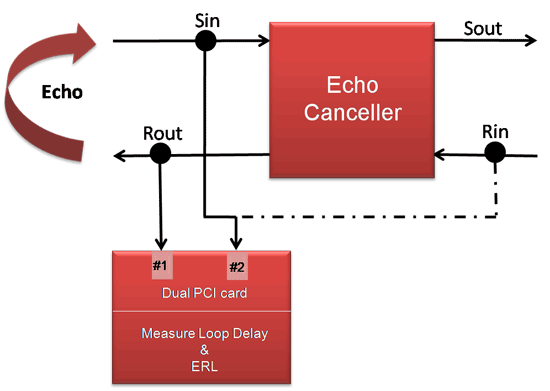
The measurement procedure is tempered by several caveats:
- There must be a minimum average power in the original signal. The threshold is -40 dBm over a 32 ms segment. If this threshold is not met by at least one portion of the original signal within a snapshot, the application judges that there is insufficient signal strength to perform a meaningful correlation. In this case, the current delay and ERL values are left unchanged.
- "Only when Off Hook" has been checked, but the channel is not off hook. In this case, the application displays "XX" for the delay and "X.X" for the ERL of the affected channel.
- Infinite return loss has been detected. This situation is somewhat similar to the first caveat above, but it is now the send path signal that has insufficient power to perform a meaningful calculation. This condition is declared if the computed return loss is greater than 60 dB, or if the signal power in the receive path is below -65 dB. In this case, the application displays "0" for the delay and "-inf" for the ERL of the affected channel.
- A "double-talk" condition has been detected. Double-talk is declared when the computed ERL is less than 6 dB. The application judges that the returned signal has been corrupted by injection injected into the double-talk
Interface
This section below describes the options used in Delay/ERL application
"Rcv Path" box -- specify the GL card to monitor or inject the test signal using this box. Press the arrow at the right of the box to drop down a list of eligible cards. If you are in non-intrusive mode (receive path data source is T1/E1 Input), the card specified here must be different than the card specified for the send path. The application will enforce this policy. "Rcv Path" is an abbreviation for "Receive Path".
"Snd Path" box -- specify the GL card to monitor the returned signal using this box. Press the arrow at the right of the box to drop down a list of eligible cards. If you are in non-intrusive mode (receive path data source is T1/E1 Input), the card specified here must be different than the card specified for the receive path. The application will enforce this policy. "Snd Path" is an abbreviation for "Send Path".
Timeslot Selectors -- Each timeslot has a selector by which you may indicate that a timeslot is to be monitored. The same timeslots are monitored on both the receive and send paths, and they are assumed to correspond.
In E1 systems, timeslot 0 is never available for monitoring. In CAS signaling mode, timeslot is also unavailable for monitoring, as it carries signaling bits and frame alignment signals. These channels are therefore "grayed out" accordingly.
If a timeslot is selected, the application will begin monitoring that timeslot on both send and receive paths and updating the timeslot's display with measured values. If the timeslot is not selected, dashes are displayed

"Select All Timeslots" -- This is used to select all timeslots at once. The application responds by setting all timeslot selectors and commencing monitoring all timeslots.
"Deselect All Timeslots" -- This is used to deselect all the selected timeslots. The application responds by resetting all timeslot selectors and ceasing the monitoring of all timeslots. The application goes idle if no timeslots are selected.
"Refresh (Sec)" - This is used to set the refresh time in seconds.
"Delay" and "ERL" display boxes -- The application displays its measurement of delay and ERL for each timeslot in these boxes. Values which have changed since the previous measurement are rendered in green. Values which have not changed since the previous measurement are rendered in black. If either Delay or ERL have changed for a timeslot, both values will be displayed in green.
As explained above, there are several circumstances under which a measurement will not be displayed, or will be superceded. The following values have special meanings:
- Dashes indicate that a measurement was not taken. Dashes will always be displayed if the timeslot is not selected. Dashes will also be displayed if the Receive Data Source is from file, but no file has been specified.
- "XX" in the Delay box and "X.X" in the ERL box indicates that the "Only When Off Hook" box was checked but the timeslot was not off hook at the beginning of the measurement period. This applies only to non-intrusive testing mode.
- "0" in the Delay box and "-inf" in the ERL box indicates that a double-talk condition existed during the entire measurement interval whenever an eligible Receive path signal was present. An "eligible Receive path signal" means a signal segment whose average power level over a 32 ms interval was greater than -40 dBm.
- A timeslot display rendered in black for a substantial period of time may mean that the power of the Receive path signal is below the power threshold. In such cases, the algorithm determines that it cannot make a meaningful determination of the Delay and ERL, and so simply retains the most recent values calculated for a valid Receive path signal. Signals that are exceptionally stationary in combination with an invariant echo loop can also give rise to this behavior.
"Delay: Minimum" and "Maximum" data fields -- Use these fields to specify the minimum and maximum delays expected in the echo path. The program uses these values as the minimum and maximum offsets when aligning the Receive path and Send path signals for computing the correlation. If the actual delay of the echo path is outside these limits, you will probably get erratic results. The maximum delay must be greater than the minimum delay. The absolute maximum allowable delay is 1 second (1000 ms).

You should resist the temptation to widen the delay range unnecessarily. Doing so increases the computational burden on the program and will lengthen the reporting interval. Although unlikely, it also does increase the chance that the algorithm will find a better correlation at some offset other than that corresponding to the actual delay. This will happen mainly with periodic signals for example, the CSS signal
Original Data Source Controls
These controls allow the user to specify the source of the original signal to be used in the test. This section explains the operation of this application for each of the possible data sources.
T1/E1 Input
You select this option by clicking the T1 or E1 Input radio button in the "Receive Path Data Source" portion of the display. The signal arriving at the T1 or E1 input is used as the original signal. Selecting this option indicates that the test will be non-intrusive. See screenshot below.
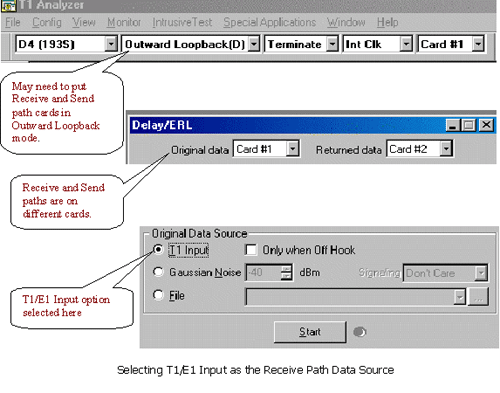
When this option is selected, the following option is also available:
"Only when Off Hook" check box -- Check this box if you only want to compute Delay and ERL when an off hook condition exists on the Receive path. When this option is selected, the application checks the signaling bits at the beginning of each receive path snapshot and compares them against the Analyzer's Off Hook signaling bits pattern. The user can view and set the Analyzer's current Off Hook and On Hook patterns under Config>T1 Configuration > Tx_Rx Tab on the T1/E1 Analyzer menu. If the timeslot is Off Hook, the Delay and ERL are calculated and displayed. If the timeslot is not Off Hook, "XX" is displayed in the timeslot's Delay box, and "X.X" is displayed in its ERL box.
Gaussian Noise Input
The Noise (dBm) radio button in the "Receive Path Data Source" portion of the display provides this option. A Gaussian-distributed white noise signal is generated by the application and used as the original signal. Selecting this option indicates that the test will be intrusive. See the screenshot below.
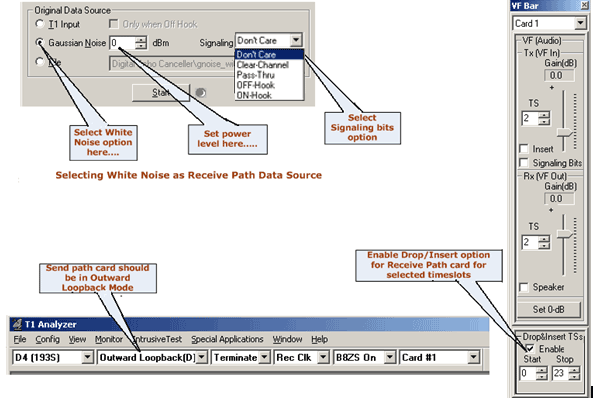
Gaussian Noise Input also includes the following options
Noise Level box-- Type the desired noise power level into this box, or use the spinner at the right of the box to increase or decrease the power level.
"Signaling" box -- This provides a drop-down menu to select the desired signaling bits. Click the desired option in the list to select it, or use the cursor control arrows to highlight your choice and then press the Enter key. The signaling bits are applied to the outgoing Receive path data stream only. The meanings of the various signaling bits options are:
- Don't Care -- The outgoing signaling bits are uncontrolled and therefore random.
- Clear Channel -'Clear channel' forces the applicable timeslot into the clear-channel condition regardless of any previous commands from any other clients or task threads, which simply states that a process has no interest in the signaling bits being transmitted.
- Pass-Thru - The incoming signaling bits received on the source card are retransmitted at the T1 or E1 output. This mode is commonly referred to as 'pass-through' or 'transparent' mode in GL Communications Inc. documentation. The Rx src Card is the card displayed in the Card box in the Rx Data Source section of the dialog.
- OFF-Hook -- The Analyzer's configured Off Hook signaling bits pattern is applied to the outgoing T1/E1 data stream.
- ON-Hook -- The Analyzer's configured On Hook signaling bits pattern is applied to the outgoing T1/E1 data stream.
The user can view and set the Analyzer's current Off Hook and On Hook patterns under Config>T1 Configuration > Tx_Rx Tab on the T1/E1 Analyzer menu.
File Input
Under "Original Path Data Source" the File Input option can be selected. If a file has been named, it is injected into the Receive path data stream. The same signal is injected into all selected timeslots. When the entire file has been transmitted, it is rewound and retransmitted. Therefore, file transmission is continuous. If no file has been selected, the application idles.
Files must contain A-Law or µ-Law encoded signal values. The Analyzer's companding law can be set in the Analyzer's main menu under Config/Encoding Option. Selecting this option indicates that the test will be intrusive. See the screenshots.
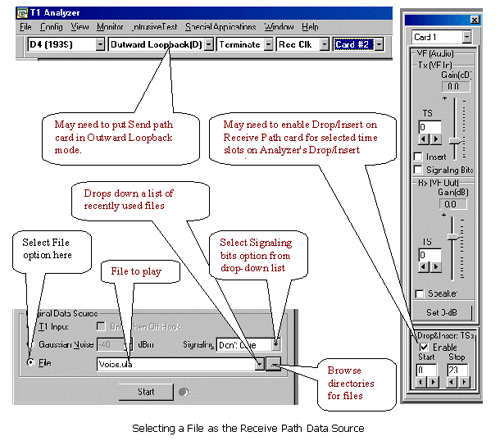
File Name - The name of the file to inject into the Receive path stream is displayed here (this is display-only field). If no file is selected this field remains blank.
"Signaling" box -- For information on this refer to Signaling section in Gaussian Noise.
Resources
Please Note: The XX in the Item No. refers to the hardware platform, listed at the bottom of the Buyer's Guide, which the software will be running on. Therefore, XX can either be ETA or EEA (Octal/Quad Boards), PTA or PEA (tProbe Units), XUT or XUE (Dual PCIe Express) depending upon the hardware.
| Item No. | Item Description |
| XX063 | Echo Path Delay/Loss Measurement Software |
| Related Software | |
|---|---|
| XX020 | Record and Playback of Files |
| XX051 | Synchronous Trunk Record Playback |
| XX051 | Synchronous Trunk Record Playback |
| XX022 | Dial DTMF/MF Digits Software (optional) |
| XX031 | Enhanced T1 / E1 Call Capture/Analysis Software (optional) |
| XX062 | Echo Path Delay/Loss Simulation Software |
| XX065 | G.168 Echo Canceller Test Suite |
| XX066 | Digital Echo Canceller |
| XX067 | Automated Echo Canceller Testing with or without VQT |
| XX068 | Semi-automated Scripted EC Testing |
| PKB070 | Audio Processing Utility |
| PKB081 | Automated Acoustic Echo Cancellation (AEC) Compliance Test Software |
| Related Hardware | |
| PTE001 | tProbe™ Dual T1 E1 Laptop Analyzer with Basic Analyzer Software |
| UTE001 | Portable USB based Dual T1 or E1 Laptop Analyzer with Basic Analyzer Software |
| HDT001/HDE001 | Legacy HD T1 or E1 (PCI) Cards with Basic Analyzer Software |
| Recommended Accessories | |
| SA013 | T1 / E1 On Site Training Class (not including travel or hotel) |
| SA021 | File Edit Software |
| SA026 | Adobe Audition Multitrack Sound File Viewing and Editing Software |
| SA048 | Goldwave Software |
| SA017A | RJ48C to RJ48C Straight Cable, 10ft. cable |
| SA017A | RJ48C to RJ48C Crossover Cable, 10ft. cable |
| SA008a | Handset Adapter with Handset |
| SA022 | Extended 1 Yr. Software Upgrades and Hardware Warranty, and Comprehensive Support for Basic and Optional Software |
| Brochures/ Presentation |
| echo canceller testing over tdm Brochure |
| Presentation |
| Echo Canceller Testing TDM and IP Interface Presentation |

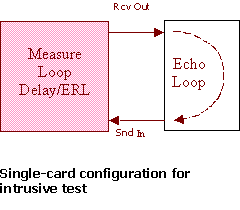


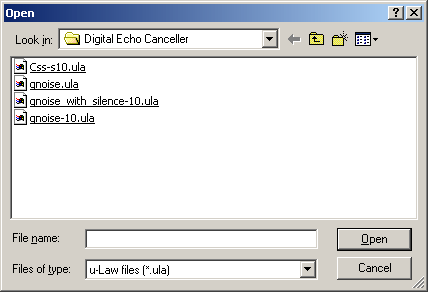
 Back to Echo Canceller Testing Solutions Main Page
Back to Echo Canceller Testing Solutions Main Page